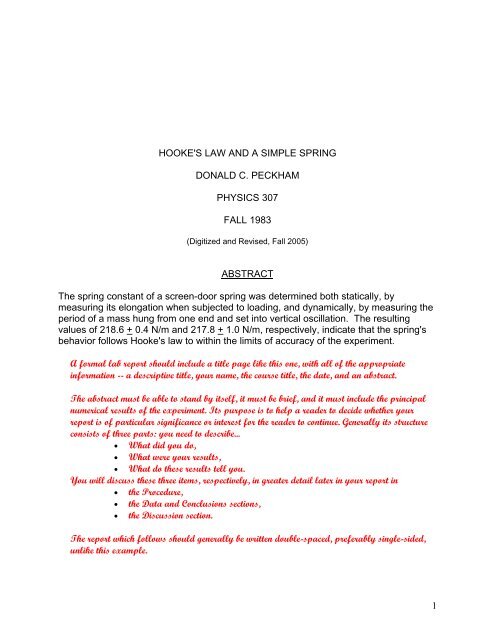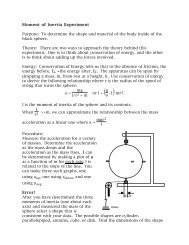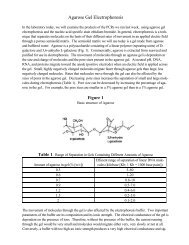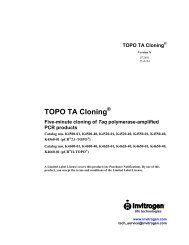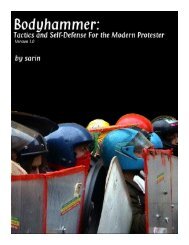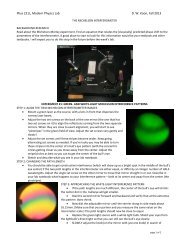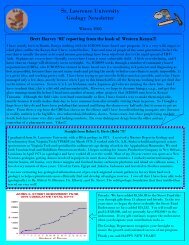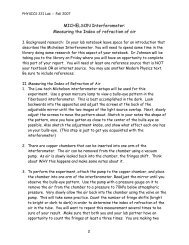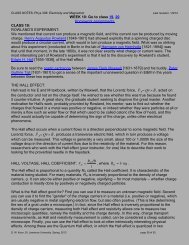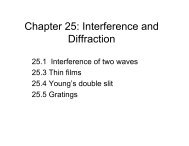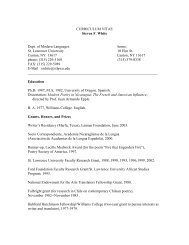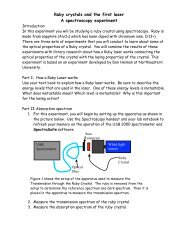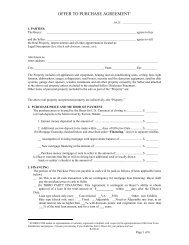HOOKE'S LAW AND A SIMPLE SPRING - St. Lawrence University
HOOKE'S LAW AND A SIMPLE SPRING - St. Lawrence University
HOOKE'S LAW AND A SIMPLE SPRING - St. Lawrence University
Create successful ePaper yourself
Turn your PDF publications into a flip-book with our unique Google optimized e-Paper software.
<strong>HOOKE'S</strong> <strong>LAW</strong> <strong>AND</strong> A <strong>SIMPLE</strong> <strong>SPRING</strong>DONALD C. PECKHAMPHYSICS 307FALL 1983(Digitized and Revised, Fall 2005)ABSTRACTThe spring constant of a screen-door spring was determined both statically, bymeasuring its elongation when subjected to loading, and dynamically, by measuring theperiod of a mass hung from one end and set into vertical oscillation. The resultingvalues of 218.6 + 0.4 N/m and 217.8 + 1.0 N/m, respectively, indicate that the spring'sbehavior follows Hooke's law to within the limits of accuracy of the experiment.A formal lab report should include a title page like this one, with all of the appropriateinformation -- a descriptive title, your name, the course title, the date, and an abstract.The abstract must be able to stand by itself, it must be brief, and it must include the principalnumerical results of the experiment. Its purpose is to help a reader to decide whether yourreport is of particular significance or interest for the reader to continue. Generally its structureconsists of three parts: you need to describe...• What did you do,• What were your results,• What do these results tell you.You will discuss these three items, respectively, in greater detail later in your report in• the Procedure,• the Data and Conclusions sections,• the Discussion section.The report which follows should generally be written double-spaced, preferably single-sided,unlike this example.1
INTRODUCTIONIf it is not stretched to the point where it becomes permanently deformed, thebehavior of a properly wound coiled spring, when subjected to a stretching force, can beexpected to follow Hooke's Law. [Bueche, p. 95] (Note that Hooke's Law applies moregenerally to many more systems than just ordinary springs.) To see whether an ordinaryscreen door spring behaves similarly, one such spring was suspended by one end froma horizontal support and masses were hung from its other end to stretch it as shown inFigure 1. The resulting data were used to construct a graph of load as a function ofelongation, from which it was possible to obtain the spring constant of the spring. Inaddition, for one value of load the spring was given a small additional stretch andreleased, thereby setting the system into vertical oscillation. Assuming this motion to besimple harmonic, its period also yields a spring constant, thereby providing an additionalcheck.Note the difference between the abstract and the introduction. The introduction indicates theprimary thrust of the experiment but does not indicate results. It does not have to stand by itselfand can refer to later parts of the report such as a diagram or a graph. Such reference shouldbe to a numbered figure or graph. (Figure 1 in this example)THEORYIt is essential that the theory section be written for the particular audience for which the report isintended. In this case, imagine your audience to consist of one of your classmates who had tomiss this week’s lab.If a weight, W = mg, is hung from one end of an ordinary spring, causing it tostretch a distance x, then an equal and opposite force, F, is created in the spring whichacts to oppose the pull of the weight. If W is not so large as to permanently distort thespring, then this force, F, will restore the spring to its original length after the load isremoved. F is thus called an elastic force and it is well known that the magnitude of anelastic restoring force is directly proportional to the stretch,F = kxNote how all quantities are defined when they first appear. Notice how the author uses italicsto set off physical quantities from the rest of the text.A relationship called Hooke's Law after the 17th century scientist who studied it. Theconstant k is called the spring constant, or stiffness coefficient. To emphasize that xrefers to the change in length of the spring we writeF = mg = kΔ l. (1)In this form it is apparent that if a plot of F as a function of Δ l has a linear portion, thisprovides confirmation that the spring follows Hooke's Law [Bueche, p. 226] and enablesus to find k.2
An additional approach is possible. One definition of simple harmonic motion(SHM) is that it is motion under a linear, “Hooke's Law” restoring force. For such amotion we have, from Newton's second law,F = - kx = ma.The minus sign appears since in this case the acceleration of the object in SHM is in thedirection opposite to the force causing it. From this definitiona2d xdt=2= −kmxWrite your equations in a form that is easy to read. In this case, Equation Editor does the job.In Microsoft Word, choose the Insert menu, then the Object menu, then select Equation Editor.The solution to this differential equation is given in standard physics textbooks [Bueche,p. 231] and the resulting expression for the period, T, of the SHM isSince your reader can be assumed to have seen this derivation previously, it is not necessary foryou to repeat it.T = 2π m / k(2)where k is again the spring constant and m is the mass which is under motion. Thisprovides an additional method for testing whether the spring obeys Hooke's Law.PROCEDUREThe Procedure elaborates on the first item of the Abstract: ‘what did you do?’ Note that theprocedure is not a step-by-step set of instructions but is meant to point out unusual ways ofdoing things or special items which another investigator would need to know in order to repeatyour work.We hung a common screen door spring directly from ahorizontal metal rod secured to the laboratory bench by a C-clamp, another pole and a right-angle clamp. We attached amass hanger directly to the bottom of the hanging spring toenable us to vary the load hanging from the spring. Verniercalipers were used to measure the vertical distances, l 0 and l 1 ,(Fig. 1) from the horizontal support rod to the top coil and thebottom coil, respectively, of the hanging spring, for a variety ofload masses ranging up to 9kg. (Table 1)Masses were added to the spring in a more or lessrandom order so as to better observe the overall correlation ofload and elongation as we graphed the data during collection.3
For ease in reading, the data are reproduced in Table 1 in order of increasing load.Mass, in kg, is plotted against elongation, in cm, in the graph in Figure 2.For the SHM part of the experiment, a single mass of 4kg was hung from thespring and the time required for the system of mass plus spring to execute an integer Nnumber of oscillations was measured with a digital stopwatch. This was repeated forthree arbitrary values of N, and the data appear in Table 2.Sketches and diagrams need not be works of art but they must clearly indicate the features theyare meant to illustrate. All relevant quantities referred to in the text of your report must beclearly displayed on the diagram.DATA <strong>AND</strong> CALCULATIONSThe Data and Calculations section elaborates on the second part of the Abstract: ‘what wereyour results?’Collect all of your data in one place. Include in the same tables derived values making sure youindicate the source of these derived values. This may require a sample calculation or a formula.Units are also essential.The measured positions of the top (l 0 ) and the bottom (l 1 ) coils of the spring aregiven below in Table 1. From these distances we calculated the length of the spring (L=l 1 -l 0 ), and the extension, ΔL, which is the difference between this extension, ΔL, and theunloaded extension of 38.8cm.In Fig. 2 we calculate the spring constant from measuring 25 to 50 separateoscillations and calculating the period of oscillation, T. From the average value of theperiod, we can use Equation 2 to calculate the spring constant, k.The mass used in calculating k was not merely the load attached to the bottom ofthe spring. The reason for this is that the system that is vibrating includes the springitself. However, the entire spring does not vibrate with the same amplitude as the loadand therefore it is reasonable to assume that the effective load is the mass hung fromthe end of the spring plus some fraction of the mass of the spring. The fraction usedwas 1/3 since similar experiments with other types of springs have led to this empiricalresult. [Sears, Zemansky, and Young] It was assumed that 1/3 of the mass was areasonable approximation to the correct value for this particular spring.Loadl01l L= l − ) ΔL(1l0kg cm cm cm cm m0 31.9 70.7 38.8 --0 32.1 70.9 38.8 38.8 01 32.0 71.1 39.1 39.1 .0032 32.1 74.3 42.2 --2 32.3 74.6 42.3 42.25 .0343 32.1 79.1 47.0 47.0 .0824 32.3 83.6 51.3 51.3 .1254
5 32.3 88.1 55.8 --5 34.4 88.3 55.9 55.85 .1716 32.4 92.6 60.2 --6 32.6 92.8 60.2 60.2 .2147 32.5 97.2 64.7 64.7 .2598 32.4 101.9 69.5 69.5 .3079 32.5 106.5 74.0 --9 32.6 106.5 73.9 73.95 .351Mass of spring70 gmAll position measurements + .05 mmAll masses + 3 gmTable 1. Calculation of the spring constant from its loaded extension.Oscillations Time (sec) T (sec)50 42.80 .85625 21.34 .85440 34.11 .853 = .854 + .002 sec.Timing oscillator - load = 4 kgTable 2. Calculation of the spring constant using the resonant frequency approach.Notice that uncertainties are also calculated. For the data in Table 2, the uncertainty used isjust the standard deviation of the collection of calculations for T. For the data in Table 1, youshould use a computer program that calculates the standard deviation of the slope and theintercept of the straight-line fit we see in Figure 2 below.Load (kg)9876543210y = 22.166x + 1.22460 0.05 0.1 0.15 0.2 0.25 0.3 0.35Δl (m)Figure 2. Load applied as a function of the resulting elongation of a screen door spring.Graphs must conform to all the rules given in the General Lab Instructions. All graphs andfigures should be numbered and referred to in the text by their number. This graph was insertedinto this Word document by a simple Copy and Paste from Excel into Word. Graphs from other5
sources may be physically cut and pasted into your report, if necessary, or converted intographical files first.DISCUSSIONThe Discussion elaborates on the third part of the Abstract: ‘what do these results tell you?’Figure 2 indicates that for loads greater than about 1.1kg (notice intercept of fit),there is a linear relation between load and elongation but that for small loads such arelationship fails, since the fit curve does not intercept the y axis at zero. It is assumedthat this is caused by an initial "set" in the spring which requires some initial load toovercome. This is apparent if one stretches the spring manually and then releases it. Itseems to snap shut at the last moment. For this reason, 0 and 1 kg were ignored andthe rest of the data were treated by a least squares analysis to determine thecoefficients of first degree polynomial best fit. These were used to plot the line on thegraph. The slope of the line, ignoring loads of less than 2kg, was found to be 22.2 ± 0.2kg/m. From Equation 1, we see that we need to multiply this quantity by g to calculate avalue for the spring constant of k = 217.4 ± 1.8 N/m.Note that final numerical values include an estimate of uncertainty.In determining k dynamically, only one value of load (4.0 kg) was used. Sincethe mass of the spring was 7.0 gm the value of m used to determine k from equation (2)was 4.023 kg. This together with = .854 ± .002 sec gives24 mk = π = 217.7 ± 1.0N/ m2TThese two values of k show agreement within the limits of accuracy of theexperiment and as such are evidence that the spring used, at least over a range ofloads from 2 to 9 kg, obeys Hooke's Law.If the dynamic experiment were extended by using a range of masses and agraph of T 2 as a function of m were constructed, a linear plot should result. For thisgraph22 (2π)T = ( m +km o),where m o would be the effective mass of the spring. This would give a more reliableresult than the estimate of 1/3 of the spring mass used here.BIBLIOGRAPHYBueche, F. J., Introduction to Physics for Scientists and Engineers, Third Edition,McGraw-Hill, N.Y. (1980).6
Wilchinsky, Z., "Theoretical Treatment of Hooke's Law," Am. J. Phys. 7, 134 (1939).Sears, F. W., Zermansky, M. and Young, H. D., <strong>University</strong> Physics, 5th Edition,Addison-Wesley, N. Y. (1981), as cited in Yost, S. A., “The effect of spring mass onthe oscillation frequency”,http://homework.phys.utk.edu/courses/spring2002/phys221/spring.pdf.Peckham, D., “Hooke’s Law: <strong>St</strong>. <strong>Lawrence</strong> <strong>University</strong> Physics Dept. Phys 307Laboratory Instructions”, Canton, N. Y. (1983),[it.stlawu.edu/~physics/InsertMadeupURLhere.html]For reports in this course your bibliography should contain at least two items. They must belisted in a standard bibliographic form. (See, for example, Hacker’s A Writer’s Reference.)Both formal and informal lab reports are subject to all the rules governing academic honesty,including issues of plagiarism, citation, and presenting others’ work as your own. You areexpected to be familiar with the rules, and your work will be considered with those rules inmind.7


